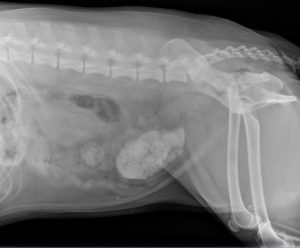
Uroliths or cystic calculi are the scientific terms for bladder stones
Uroliths or cystic calculi are the scientific terms for bladder stones. They are rock-like minerals that develop in the urinary bladder. These formations could be one large, single stone or stones that range in size from sand-like grains to gravel. Commonly, there is a mixture of small and large stones. If you notice that your canine companion has blood in their urine and trouble urinating at all, you should give us a call. Today, we will look at the causes, diagnosis, and treatment of bladder stones in dogs.
How Does a Dog Develop Bladder Stones?
There are multiple theories of how dogs develop bladder stones. The most commonly accepted cause is that one or more stone-forming crystalline compounds are present in elevated levels in the urine due to dietary factors or underlying disease in the bladder, particularly a bacterial infection. Bladder stones could also form due to an issue with the body’s metabolism.
When the amount of this stone-forming crystalline compound exceeds a threshold level, the urine becomes saturated and cannot hold it any longer. The saturation level all depends on the specific minerals that exist and the urine’s pH level. These additional compounds precipitate out of the solution and form tiny crystals. These sharp crystals irritate the bladder lining, causing mucus. When mucus combines with these crystals, they form clusters that enlarge over time and harden into stones.
Diagnosis
Commonly, bladder stones are visible on radiographs or X-rays or an ultrasonic bladder examination. Some bladder stones can be translucent, meaning they are not visible on X-Rays because their mineral composition doesn’t reflect X-Ray beams. If this is the case, an ultrasound examination or radiographic contrast study may need to be performed. A radiographic contrast study involves administering a dye or contrast material into the bladder to outline the stones within the bladder.
Treatment
- Surgical Removal: This method is the quickest way to get rid of bladder stones. With general anesthesia, a veterinarian can remove the stones via a cystotomy. Of course, our team of experts will thoroughly review if this is the best option for your dog based on their health history.
- Urohydropropulsion: If the stones are small enough, we can insert a catheter into the bladder to flush the stones out. This is not a surgical procedure but does require sedation.
- Dietary dissolution: Dietary dissolution can work on specific types of stones and if they are small enough. Our medical experts can develop a unique nutritional plan for your canine companion based on which stones are present in your dog’s body. Prescription diets are also used as maintenance to prevent stones from developing in the future.
Please keep your pets healthy and keep yourself well-informed by continuing to read our weekly content!
Here at Mount Carmel Animal Hospital, We’ll Treat Your Pets Like Family!
Mount Carmel Animal Hospital has been serving the Northern Baltimore/Southern York community for over 30 years and is proud to be an independently operated, small animal practice committed to excellence in veterinary medicine and client service. From grooming to wellness services, along with Canine Life Skills Training Courses, and surgical procedures, we have the expertise that will best serve the needs of you and your pet. Contact us at 410-343-0200 and follow us on Facebook!
